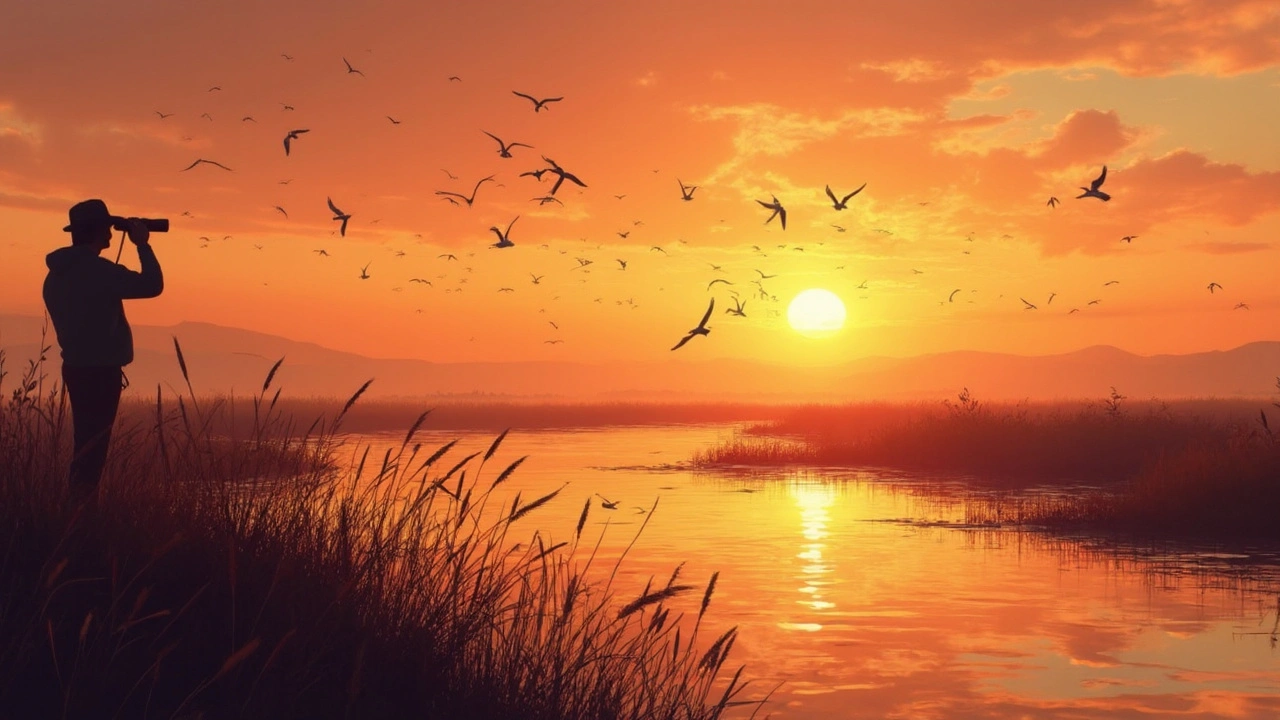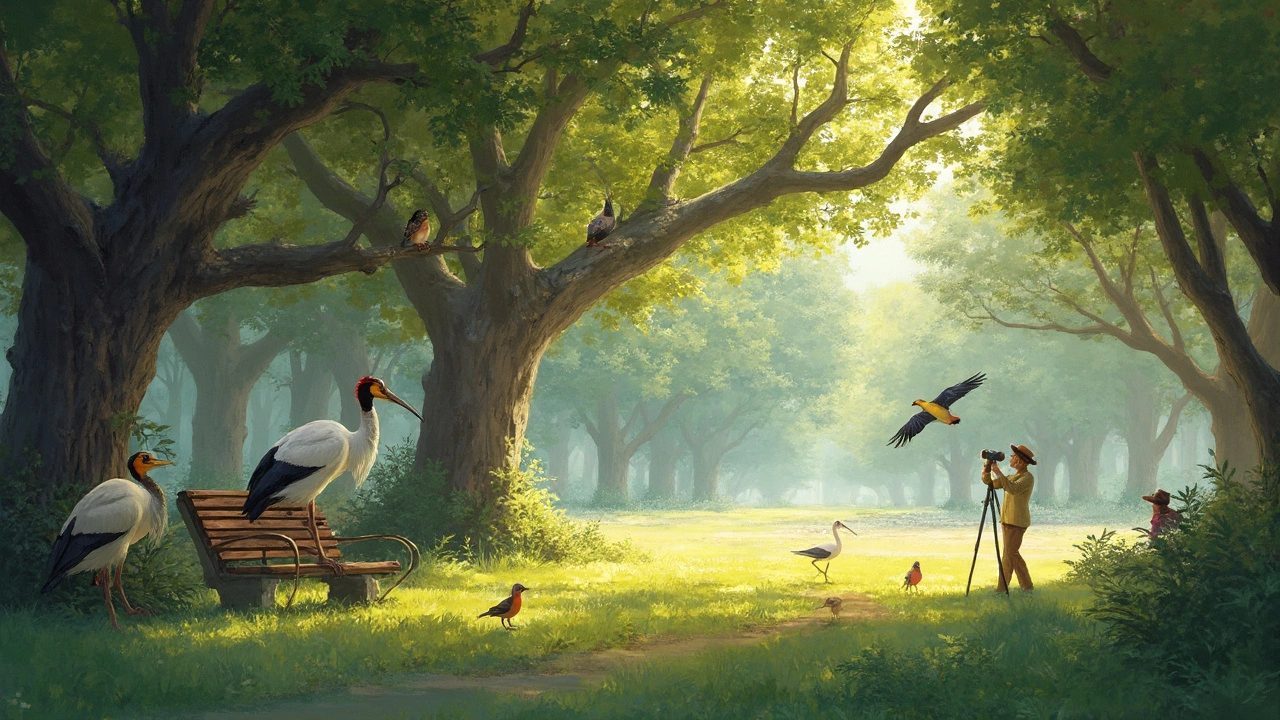If you're a nature lover with an eye for feathered friends, you're probably always on the lookout for the best birdwatching spots. So where exactly should you go? Some parks are absolute havens for bird enthusiasts, offering a front-row seat to nature's wondrous displays.
Birdwatching parks can be found in many regions, and they often boast a wide array of bird species that delight casual observers and serious twitchers alike. Picture this: a peaceful morning, the sun rising, and the melodic calls of birds filling the air. Sounds enticing, right?
But before you head out, there are a few things you might want to consider like the best times to visit and what gear you'll need to bring along. After all, a great birdwatching experience is as much about being prepared as it is about being in the right place at the right time. Let's explore the ins and outs of making the most out of these natural wonderlands!
- Key Takeaways
- Why Visit Birdwatching Parks?
- Top Parks for Birdwatchers
- Ideal Times and Gear for Birdwatching
- Birdwatching Tips for Beginners
- FAQs and Final Thoughts
Key Takeaways
Are you a fan of nature and looking for some of the best birdwatching parks? These places are more than just spots; they're gateways to the fascinating world of birds. Here are some key takeaways to keep in mind when setting off on your birdwatching adventure.
The diversity of bird species you'll find varies by location, but many parks boast over 100 different types! Imagine spotting a rare warbler or a majestic hawk in action. Knowing the types of birds that frequent an area can boost your chances of a successful sighting.
Why These Parks Stand Out
- Unique Ecosystems: Many parks are built around lakes, rivers, and forests that provide rich habitats for birds.
- Seasonal Migration: Some parks are prime spots during migration seasons, where you might catch a glimpse of species not commonly found there year-round.
- Accessibility: Most parks have clearly marked trails and observation points for both beginners and seasoned birders.
Essential Tips for Birdwatching
- Bring a pair of good binoculars to get a closer view without disturbing the birds.
- Wear clothing that blends in with your surroundings to avoid scaring them away.
- Visit during early morning or late afternoon when birds are most active.
Understanding the Birdwatching Community
Birdwatching isn't just about seeing birds; it's also about connecting with other enthusiasts. Many parks host events where you can learn from seasoned birdwatchers, making your experience even more enriching.
Whether you're venturing out on your own or joining a group, your journey to these birdwatching parks is bound to be both exciting and rewarding.
Why Visit Birdwatching Parks?
Birdwatching parks are like treasures for anyone who appreciates the sights and sounds of nature. But why should you go out of your way to visit these places? Let’s dive into that a bit.
Spot Rare Species
Many birdwatching parks are home to rare and migratory species that you simply won't find in your backyard. These parks offer a unique chance to see those hard-to-spot birds. For instance, Yellowstone National Park is known for hosting over 300 species, including the elusive Peregrine Falcon. Imagine ticking off that beauty from your checklist!
Connect with Nature
In our fast-paced world, finding a place to unwind can be tough. Birdwatching offers a peaceful way to recharge. Parks are ideal for this as they combine beautiful landscapes with the tranquil enjoyment of birds in their natural habitat. It’s a wonderful way to disconnect from technology and reconnect with the environment.
Learning in the Wild
Birdwatching is also a fantastic educational activity. Whether you’re young or just young at heart, birdwatching parks often have guides or information centers. They provide insights into bird behaviors, flight patterns, and conservation efforts. You could even join a guided tour if you want to dig deeper.
Join a Community
Visiting birdwatching parks is not just about the birds. It's also about meeting like-minded individuals. You might find local birding clubs organizing events or walks, making it easy to share tips and enjoy the company of fellow bird lovers. It's a great way to make friends and share your passion.
Photography Opportunities
If photography is your thing, these parks are perfect photo ops. You have the chance to capture stunning images of birds against breathtaking backdrops. Just ensure you have a good zoom lens—it’ll make all the difference when trying to photograph that rare bird in action!
With reasons like these, visiting a birdwatching park is a no-brainer for anyone who loves nature and wants more from their outdoor adventures.
Top Parks for Birdwatchers
If you're eager to catch a glimpse of nature's finest in their natural habitats, these birdwatching parks should top your list. Whether you’re a newbie or a seasoned bird enthusiast, there’s something here for everyone.
Central Park, New York City
Bet you didn’t see that coming! Central Park isn’t just for joggers and musicians; it’s one of the most unexpected treasures for birdwatchers. Over 270 species have been spotted here, especially during migration. Check out the Ramble area—it's a must-visit spot.
Everglades National Park, Florida
Known for its unique wetlands, the Everglades boasts an eclectic collection of wading birds. Pack your binoculars around the Nine Mile Pond for some interesting finds. It's not unusual to see a variety of egrets and the sneaky herons here.
- Best Time: December to March
- Key Species: Roseate Spoonbill, Wood Stork
Point Reyes National Seashore, California
This place is a haven for bird lovers on the West Coast. With more than 490 species, you could spot everything from hawks to colorful warblers. Plus, the coastal landscapes are pretty stunning too!
- Best Time: Spring and Fall
- Key Species: Peregrine Falcon, Northern Spotted Owl
These parks aren’t just great for the birds; they offer a peaceful, serene setting for you to kick back and enjoy nature’s show. Make sure to check park regulations and have a map handy. And, if you’re into documenting your sightings, bring along a good camera for some amazing shots!

Ideal Times and Gear for Birdwatching
Getting the timing and equipment right can turn a birdwatching outing from a casual stroll into an unforgettable adventure. So, when should you head out, and what should you bring along?
Best Times to Go Birdwatching
For a rewarding experience at your favorite birdwatching parks, timing is everything. Generally, the early bird gets the, well, birds! Mornings, especially around sunrise, are often the best times. Birds are more active at dawn when they're foraging for food and singing their hearts out. If you’re not a morning person, late afternoon, as the sun begins to set, is also a good time. Birds tend to become active again as they wrap up their day. Keep in mind that different seasons bring different feathered visitors. Migration periods in spring and fall can be particularly exciting as many species pass through.
Essential Birdwatching Gear
Heading out into nature doesn't require mountains of gear, but a few essentials will make your time more rewarding. Here's a quick checklist:
- Binoculars: Invest in a quality pair. Look for ones with at least 8x magnification. They’ll help you spot details and identify birds from afar.
- Field Guide: A good bird field guide is invaluable to identify different species. Many birdwatchers now use apps for convenience.
- Notepad: Note down your sightings. It’s a handy way to track what you've seen.
- Comfortable Clothing: Dress in layers and wear neutral colors. Birds scare easily, so you want to blend in as much as possible.
- Camera: If you're into photography, a good camera with a zoom lens is great for capturing spectacular shots.
Optional but Handy Gear
Once you’ve got the basics down, consider these extra goodies to enhance your experience:
- Bird Call App: Sometimes you can attract birds by mimicking their calls. Apps are available that replicate these sounds!
- Backpack: A small daypack can carry snacks, water, and any other personal items for a longer birdwatching trip.
With this gear at your disposal and knowledge of the ideal times, you're set for a stellar day at your local birdwatching parks. Ready to hear those melodies and catch a glimpse of rare birds overhead?
Birdwatching Tips for Beginners
Starting your journey as a birdwatching enthusiast can feel a bit overwhelming. But with a few simple tips, you'll be spotting and identifying birds like a pro in no time!
Get the Right Gear
First things first, you'll need at least a good pair of binoculars. Opt for something lightweight and comfortable since you'll be carrying them around a lot. A field guide is also essential—there are apps available now that can help identify birds based on location and traits.
Know Your Spot
Researching the best parks known for birdwatching can help you start off strong. Websites like Audubon have great resources for finding birdwatching parks near you. Knowing your location can increase your chances of spotting not only common birds but rare ones too!
Master the Art of Patience
Sitting still isn’t just for meditation; it's crucial in birdwatching. Birds can be shy, and sudden movements might scare them away. Try finding a comfortable spot and let the birds come to you.
Start with Common Birds
Before you start looking for those hard-to-find species, familiarize yourself with the common birds in your area. This not only makes identifying them easier but also gives you a confidence boost.
Time Your Birdwatching
The early bird catches the worm—literally. Birds are most active in the early morning and late afternoon, so plan your visits to parks during these times for the best experience.
Record and Reflect
Keeping a birdwatching diary or log can help track your progress and make your birding trips more rewarding. Note down the species you spot, where you saw them, and any interesting behavior.
| Tip | Benefit |
|---|---|
| Use Binoculars | Enhanced viewing |
| Visit Early | High bird activity |
| Stay Still | Better observations |
By following these tips, you'll find yourself not only enjoying the great outdoors but also becoming quite the expert in spotting and identifying birds. Happy birdwatching!
FAQs and Final Thoughts
So, you've got questions about birdwatching parks? We've got answers! This section is all about clearing up those lingering thoughts, and making sure you're ready to embark on your adventure with all the confidence in the world.
What should I bring for a day of birdwatching?
The essentials include a pair of good binoculars, a notebook for jotting down your observations, and a bird guidebook for identifying species. Don't forget water and snacks to keep your energy up, and a camera if you love capturing moments.
When is the best time to visit a birdwatching park?
Early mornings or late afternoons are prime times when birds are most active. Depending on the region, the spring and fall migrations can be excellent for observing a variety of birds.
Can beginners enjoy birdwatching parks?
Absolutely! Many parks offer guided walks or tours for beginners, and it's a welcoming hobby. Even if you don't identify every species, simply being out in nature and enjoying the sights and sounds is rewarding in itself.
Are there any specific parks known for their bird diversity?
Yes! Places like the Everglades National Park in Florida and Point Pelee National Park in Canada are famous for their rich biodiversity. These parks host hundreds of bird species, making them the perfect spots for bird enthusiasts.
Here’s a quick comparison to show you what to expect from different parks:
| Park Name | Region | Peak Seasons | Bird Species Count |
|---|---|---|---|
| Everglades National Park | Florida, USA | Spring, Fall | 360+ |
| Point Pelee National Park | Ontario, Canada | May | 390+ |
Any final tips for a great birdwatching experience?
Patience is key. Birds are unpredictable, and part of the fun is the surprise of what you might see. Stay quiet, move slowly, and most importantly, enjoy the lovely escape from the hustle and bustle.
Ready to dive into the world of birdwatching? These parks are waiting to share their avian wonders with you. It's a hobby that not only connects you with nature but provides endless excitement and learning opportunities. Happy birdwatching!










